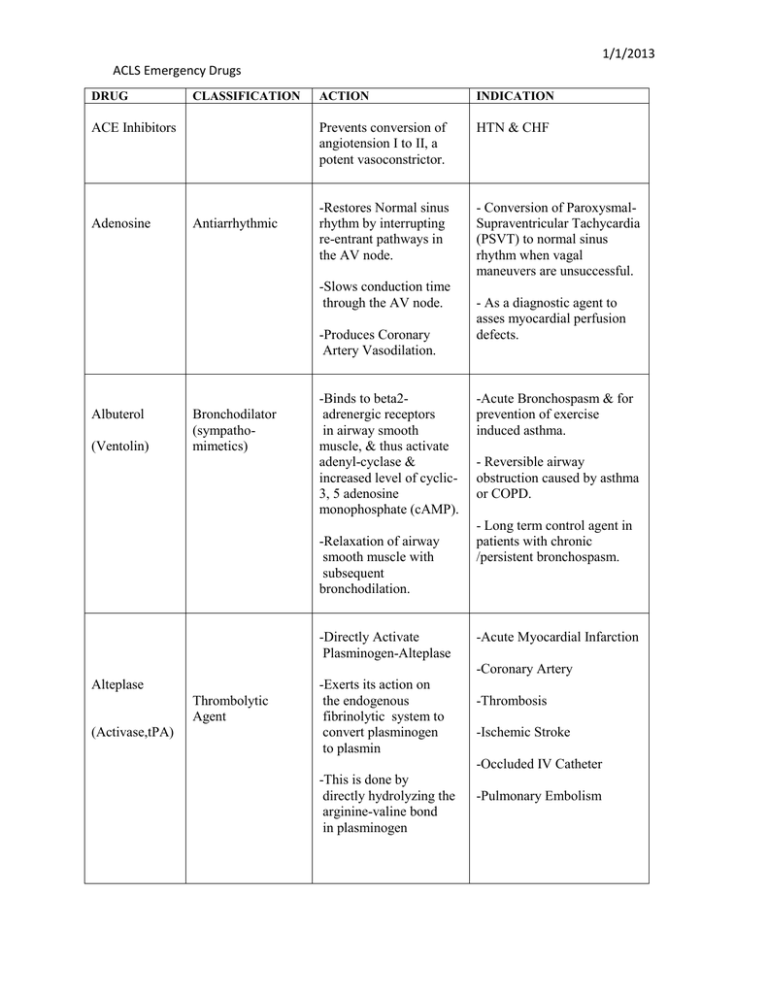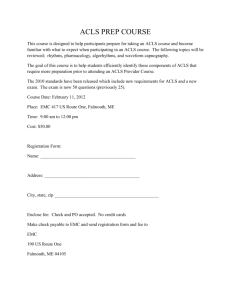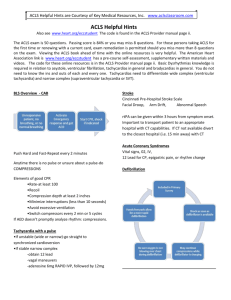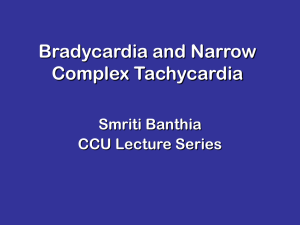Document 11468256
advertisement

1/1/2013 ACLS Emergency Drugs DRUG CLASSIFICATION ACE Inhibitors Adenosine Antiarrhythmic ACTION INDICATION Prevents conversion of angiotension I to II, a potent vasoconstrictor. HTN & CHF -Restores Normal sinus rhythm by interrupting re-entrant pathways in the AV node. - Conversion of ParoxysmalSupraventricular Tachycardia (PSVT) to normal sinus rhythm when vagal maneuvers are unsuccessful. -Slows conduction time through the AV node. -Produces Coronary Artery Vasodilation. Albuterol (Ventolin) Bronchodilator (sympathomimetics) -Binds to beta2adrenergic receptors in airway smooth muscle, & thus activate adenyl-cyclase & increased level of cyclic3, 5 adenosine monophosphate (cAMP). -Relaxation of airway smooth muscle with subsequent bronchodilation. -Directly Activate Plasminogen-Alteplase - As a diagnostic agent to asses myocardial perfusion defects. -Acute Bronchospasm & for prevention of exercise induced asthma. - Reversible airway obstruction caused by asthma or COPD. - Long term control agent in patients with chronic /persistent bronchospasm. -Acute Myocardial Infarction -Coronary Artery Alteplase Thrombolytic Agent (Activase,tPA) -Exerts its action on the endogenous fibrinolytic system to convert plasminogen to plasmin -Thrombosis -Ischemic Stroke -Occluded IV Catheter -This is done by directly hydrolyzing the arginine-valine bond in plasminogen -Pulmonary Embolism 1/1/2013 ACLS Emergency Drugs DRUG CLASSIFICATION ACTION INDICATION -Prolongs action potential & refractory period -Ventricular Fibrillation Amiodarone (Cordarone, Pacerone) Antiarrhythmic ( Class III) -Inhibits adrenergic stimulation -Supra-ventricular Tachycardia -Slows the sinus rate, increases PR and QT intervals -Decreases peripheral vascular resistance -Acute Myocardial Infarction -Platelet Inhibitor Aspirin (ASA) -Decreases Platelet Aggregation -Salicylate -Angina -Arterial Thromboembolism -Prophylaxis -Arthralgia -Ischemic Stroke Atropine Antiarrhythmics Anticholinergics (antimusccarinic) -Accelerates the HR by blocking parasympathetic nervous system. -Enhances sinus node automaticity and AV Conduction. Effects of Atropine on the heart is almost entirely to its electrical activity. Atropine Sulfate Parasympatholytic -Inhibits actions of acetylcholine at postganglionic parasympathetic neuroeffector sites, primarily at muscarinic receptors -Symptomatic Bradycardia; Bradycardia with PVC’s; Asystole; PEA with rate < 60 after Epinephrine; May be useful in AV blocks – 1st degree AVB, 2nd Degree Type I (Wenckebach); Watch carefully for slowing. -Hemodynamically Significant Bradycardia; Asystole; Organophosphate Poisoning; Pulseless Electrical Activity 1/1/2013 ACLS Emergency Drugs DRUG CLASSIFICATION Betablockers Calcium Channel Blockers Mineral and electrolyte replacements/supple ments ACTION INDICATION -a – adrenergic receptor blockade; Antidysrhythmic -Effective antiarrhythmic; Decreased incidence of VF in post MI patients; May decrease rate of nonfatal reinfarction; Slows HR & treat rhythm problems; Decreased myocardial ischemia by decreasing O2 requirements; Decreased blood pressure. -Act as an activator Inhibit the flow of Ca+ across the cell membrane Relax arterial smooth muscle -Emergency treatment of hyperkalemia and hypermagnesemia and adjunct in cardiac arrest. -Hypocalcaemia. -Slow rate of SA node & AV node conduction -Prevents reentry arrhythmia’s Slow HR & Decrease myocardial O2 demand Calcium Chloride Dextrose 50% Electrolyte Nutrient -Treatment for essential hypertension; Prophylaxis of angina pectoris; Prevent/control SVT & Sinus Tachycardia; Prevent neurologic damage due to subarachnoid hemorrhage -Maintain cell membrane and capillary systems; act as an activator in the transmission of nerve impulses and contraction of cardiac, skeletal, and smooth muscle -Hypocalcemia Glucose Replacement -Hypoglycemia -Hyperkalemia -Hypermagnesemia -Hyperkalemia 1/1/2013 ACLS Emergency Drugs DRUG Diltiazem (Cardizem) CLASSIFICATION ACTION INDICATION -Antiarrhythmic (class IV) -Inhibits the transport of calcium into myocardial and vascular smooth muscle cells; resulting in inhibition of excitationcontraction coupling and subsequent contraction -Angina pectoris and vasospastic (Prinzmetal’s) angina. -Antianginal -Antihypertensive Agent - Systemic vasodilation resulting in decreased blood pressure. - Supraventricular tachycardia and rapid ventricular rates in atrial flutter or fibrillation. - Management of Raynaud’s syndrome. -Coronary vasodilation -Suppression of arrythmias Diphenhydrami ne (Benadryl) Antihistamine Allergy Cold Remedies Antitussives Digitalis Antiarrhythmic Inotropic -Antagonizes the effects of histamine at H1 receptor sites ; does not bind to or inactivate histamine -Significant CNS depressant and anticholinergic properties - Improves myocardial contraction by altering the calcium utilization by myocardial cells -Prolongs refractory period of the AV node -Anaphylaxis -Seasonal and perennial allergic rhinitis -Allergic dermatosis -Parkinson’s disease and dystonic reactions from medications. -Mild nighttime sedation -Prevention of motion sickness -Antitussive (Syrup only). -Congestive Heart Failure (CHF) -atrial Fibrillation -atrial flutter -Decreases conduction through the SA and AV node 1/1/2013 ACLS Emergency Drugs DRUG CLASSIFICATION Antiarrhythmic Digoxin (Lanoxin) Dopamine (Intropics, Vasopressors) Inotrope Sympathomimetic Inotropics Vasopressor ACTION -Increases the force of myocardial contraction -Prolongs refractory period of the AV node -Decreases conduction through the SA and AV nodes -Stimulates dopaminergic and beta1-adrenergic receptors ; producing cardiac stimulation and renal vasodilation (Small Doses). -Cardiac stimulation and renal vasodilation (Large doses). INDICATION Atrial Fibrillation Heart Failure -Adjunct to standard measures to improve: Blood pressure, Cardiogenic Shock, Cardiac output, Urine output in treatment of shock unresponsive to fluid replacement. -Heart Failure -Hypotension -Septic Shock Dobutamine Sympathomimetic Inotropics -Stimulates beta-1 (myocardial) – adrenergic receptors with relatively minor effect on heart rate or peripheral blood vessels. -Short term (<48 hrs) management of heart failure caused bb depressed contractility from organic heart disease or surgical procedure. -dobutamine is mostly a beta-1 selective synthetic catecholamine with mild alpha-1 and beta-2 activity and therefore has mostly positive inotropic and chronotropic effects on the heart; dobutamine will often increase cardiac output with less tachycardia and arrhythmia than dopamine -Used for Pump problems with systolic blood pressure 90-100 CHF, Pulmonary Congestion & CardiogenicPulmonary Edema -Hypotension and Shock 1/1/2013 ACLS Emergency Drugs DRUG CLASSIFICATION ACTION INDICATION Epinephrine (Adrenalin) Antihistamics -Results in accumulation of cAMP at beta adrenergic receptors. -Management of reversible airway disease due to asthma or COPD, severe allergic reactions. Bronchodilators Vasopressors -Affects both beta (cardiac) adrenergic receptors and beta (pulmonary) adrenergic receptors. -Acute Brochospasm -Anaphylaxis -Angioedema -Produces bronchodilation -Alpha-adrenergic agonist properties -Resulting in vasoconstriction -Inhibits the release of mediators of immediate hypersensitivity reactions from mast cells Furosemide (Lasix) Diuretic -Asthma; Bronchospasm Prophylaxis -Cardiac Arrest; Glaucoma Pulseless Electrical Activity Ventricular Asystole Ventricular Fibrillation Surgical Bleeding -Inhibit the reabsorption of sodium and chloride from the loop of Henle and distal renal tubule -Edema -Increase renal excretion of water, sodium, chloride, magnesium, hydrogen, and calcium -Neophrotic Syndrome -Heart Failure -Hypertension -Pulmonary Edema -Renal Impairment Fibrinolytic Therapy -Thrombolytic Enzymes binds to fibrin, converts plasminogen to plasmin initiating local fibrinolysis. -Lysis of thrombi obstructing coronary arteries in Acute MI; Acute Ischemic Stroke; Pulmonary Embolism 1/1/2013 ACLS Emergency Drugs DRUG CLASSIFICATION Fibrolytic Agents Heparin Anticoagulant ACTION INDICATION -Activate both soluble plasminogen and surface bound plasminogen to plasmin when generated close to fibrin clot digest fibrin and dissolves the clot. -Lysis of thrombi obstructing coronary arteries in acute MI; Ideally within the first 6 hours of onset of symptoms; Re-establish blood flow to infarct related artery; Goal door to drug < 30 min.; Acute Ischemic Stroke with 3 hours of onset of symptoms -In low doses, prevents the conversion of prothrombin to thrombin by its effect on factor Xa; -Various thromboembolic disorders including: Venous thromboembolism, pulmonary emboli, atrial fibrillation with embolization, acute and chronic consumptive coagulopathies, peripheral arterial thromboembolism. -Higher doses neutralize thrombin, preventing the conversion of fibrinogen to fibrin -Acute Myocardial Infarction -Arterial thromboembolism -Deep Venous Thrombosis -Unstable Angina -Prosthetic Heart Valves Ibutilide Antiarrythmics ( Class III) -Decrease the heart rate and AV conduction by activating a slow inward Na Current -Mildly slows sinus rate and AV conduction. -Short acting antiarrhythmic; Treatment for recent onset Atrial Fibrillation and Atrial Flutter – 3 hours to 90 days 1/1/2013 ACLS Emergency Drugs DRUG CLASSIFICATION ACTION Sympathomimetic Inotrope -Potent Agonist of both Beta1and Beta2- adrenergic receptors -Intracellularly, the actions are mediated by cyclic adenosine monophosphate INDICATION -Acute Bronchospasm Isoproterenol (Isuprel) Adrenergic Agonist Lidocaine (Xylocaine) Antiarrhythmic (Class IB) Anesthetic -Asthma -AV Block -Bradycardia -Cardiac Arrest -The production of which is augmented by beta stimulation. -Adams-Strokes Syndrome -Suppresses automaticity and spontaneous depolarization of the ventricles during diastole by altering the flux of sodium ions across cell membranes with little or no effect on heart rate -Ventricular arrhythmias -Torsade De Pointes -Anesthesia, Pain -Sympathetic Nerve Block -Ventricular Fibrillation -Ventricular Tachycardia -Inhibiting transport of ions across neuronal membranes Magnesium Magnesium Sulfate Electrolyte -Plays important role in neurotransmission and muscular excitability. -Torsades de Pointes – Drug Induced; Suspected hypomagnesium; Sever recurrent or refractory V-fib -Essential for the activity of many enzymes -Plays an important role in neurotransmission and muscular excitability -Hypomagnesemia -Eclampsia -Preeclampsia 1/1/2013 ACLS Emergency Drugs DRUG CLASSIFICATION ACTION INDICATION Midazolam Antianxiety agents, sedative/hypnotics -Depressant action at all levels of CNS -Conscious sedation for cardioversion - Relieve anxiety and produce amnesia Morphine Opioid Analgesics -Severe pain -Causes Vasodilation which reduces myocardial oxygen consumption -Analgesia Sedation -Pulmonary Edema due to CHF -Pain associated with AMI (f NTG not working) -Dilate blood vessels -Emergency treatment of Cardiogenic-Pulmonary Edema Morphine Sulfate Analgesic -Binds to opiate receptors in the CNS -Pulmonary Edema -Alters the perception of and responds to painful stimuli while producing generalized CNS depression Naloxone (Narcan) -Severe Pain Opiate Antagonist -Competitively blocks the effects of opioids, including CNS and respiratory depression ,without producing any agonist effects. -Pain associated with Myocardial Infarction -Reversal of CNS depression and respiratory depression because of suspected opioid overdose i.e. Opiate Agonist Overdose -Opiate Agonist-Induced respiratory Depression 1/1/2013 ACLS Emergency Drugs DRUG Nitroglycerin CLASSIFICATION ACTION INDICATION Antianginals -Increase coronary blood flow by dilating coronary arteries and improving collateral flow to ischemic regions. -Acute and long term management of angina pectoris. -Vasodilator -Reduces myocardial oxygen consumptions -Decreases Preload (enddiastolic volume), & left ventricular end-diastolic pressure. Nitroprusside Antihypertensives -Potent rapid acting peripheral vasodilator reduces peripheral arterial pressure (preload & afterload) -Adjunct treatment of CHF Associated with acute Myocardial Infarction -Heart Failure -Hypertension Pulmonary Edema Unstable Angina -Hypertension crises -Controlled hypotension during anesthesia -Cardiac pump failure or Cardiogenic Shock -AMI, if Nitroglycerin not effective Norepinephrine (Levophed, Noradrenaline) Sympathomimetic Inotrope -It is an endogenous catecholamine synthesized in the adrenal medulla Vasopressor -Cardiogenic Shock -Hypotension -Septic Shock -It is the biochemical precursor of epinephrine -Norepinephrine is the transmitter of most sympathetic post ganglionic fibers of the CNS. 1/1/2013 ACLS Emergency Drugs DRUG CLASSIFICATION ACTION INDICATION -Acute Chest Pain -Improves tissue oxygenation and hemoglobin saturation when circulation is maintained. Oxygen -Hypoxia -Cardiopulmonary Arrest -Pulmonary Edema Phenytoin (Dilantin, DPH) Anticonvulsant Antiarrythmic (Class IB) -Antiarrhythmic properties as a result of improvement in AV conduction -Seizure ( Tonic- clonic – grand-mal seizures & complex partial seizures). -Status Epilepticus -Limit seizure propagation by altering ion transport -Decrease synaptic transmission Procainamide (Pronestyl) Antiarrhythmic ( Class IA) -Decreases myocardial excitability -Slows conduction velocity -May depress myocardial contractility -Treatment of wide variety of ventricular and atrial arrythmias, including; PVC’s, Ventricular tachycardia, Paroxysmal atrial tachycardia - Maintenance of normal sinus rhythm after conversion from atrial fibrillation or flutter. -Cardiopulmonary Resuscitation Quinidine Antiarrhythmic Class IA -Decreases myocardial excitability Atrial pre-mature contraction -Slows conduction velocity (Prolongs the QT interval) -Premature ventricular contraction -Paroxysmal atrial tachycardia -Venricular tachycardia 1/1/2013 ACLS Emergency Drugs DRUG CLASSIFICATION ACTION INDICATION Reteplase (Retavase) Thrombolytic Agent -Directly Activate Plasminogen Alteplase exerts its action on the endogenous fibrinolytic system -To convert plasminogen to plasmin by directly hydrolyzing the argininevaline bond in plasminogen. -Acute Myocardial Infarction -Acts as an alkalinizing agent by releasing bicarbonate ions -Cardiac Arrest Sodium Bicarbonate -Alkalinizing Agent -Electrolyte Replacement -Following oral administration releases bicarbonate, which is capable of neutralizing gastric acid -Coronary Artery Thrombosis -Cardiopulmonary Resuscitation -Dyspepsia -Hyperkalemia -Metabolic Acidosis -Pyrosis -Urinary Alkalinization Sotalol Antiarrhythmic (Class II and III) Blocks stimulation of beta1 (myocardial) and beta2 (pulmonary and vascular) Life-threatening ventricular arrhythmias -Maintenance of normal sinus rhythm in patients with highly symptomatic atrial fibrillation/atrial flutter 1/1/2013 ACLS Emergency Drugs DRUG CLASSIFICATION ACTION INDICATION Streptokinase (Streptase) Thrombolytic Agent -Directly Activate Plasminogen -Alteplase exerts its action on the endogenous fibrinolytic system -Acute management of coronary thrombosis (MI) -Arterial thrombo-embolism -Deep Venous Thrombosis -Pulmonary Embolism -To convert plasminogen to plasmin by directly hydrolyzing the arginine-valine bond in plasminogen Tenecteplase (TNKase) Vasopressin (Pitressin, ADH) Thrombolytic Agent Pituitary Hormones (antidiuretic hormones) -Occluded Arteriovenous Cannula -Directly Activate Plasminogen; -Alteplase exerts its action on the endogenous fibrinolytic system -To convert plasminogen to plasmin by directly hydrolyzing the arginine-valine bond in plasminogen -Acute Myocardial Infarction -Alters the permeability of the renal collecting ducts, allowing reabsorptions of water -Central diabetes insipidus due to deficient AHD -Directly stimulates musculature of the GI tract -Nonadrenergic peripheral Vasoconstrictor -Coronary Artery -Thrombosis 1/1/2013 ACLS Emergency Drugs DRUG CLASSIFICATION ACTION INDICATION Verapamil (Isoptin) -Antiarrhythmic -Inhibits the transport of calcium into myocardial and vascular smooth muscle cells -Management of: Angina pectoris or vasospastic (Prinzmetal’s) angina, Atrial Fibrillation, Atrial Flutter, Hypertension, Paroxysmal Supraventricular Tachycardia (PSVT -Antianginal - Antihypertensive Agent -Vascular headache suppressants Disopyramide Antiarrhythmic Class I -Resulting in inhibition of excitation-contraction coupling and subsequent contraction -Decreases myocardial excitability Unifocal or multifocal PVCs -Slows conduction velocity -Paired PVCs -Little effect on heart rate but has a direct negative inotropic effect -Ventricular tachycardia -Supraventricular tachyarrhythmia 1/1/2013 ACLS Emergency Drugs DEFINITIONS Adrenergic Adrenergic Agonist Cholinergic Diabetes Insipidus Embolism Embolus Hyperkalemia Inotrope Activated by, characteristic of, or secreting epinephrine or related substances, particularly the sympathetic nerve fibers that liberate norepinephrine at a synapse when a nerve impulse passes. is a drug that has an affinity for and stimulates physiologic activity at cell receptors normally stimulated by naturally occurring substances means related to the neurotransmitter acetylcholine, and is typically used in a neurological perspective. The parasympathetic nervous system is entirely cholinergic. Neuromuscular junctions, preganglionic neurons of the sympathetic nervous system, the basal forebrain, and brain stem complexes are also cholinergic. is a disease of the pituitary gland or kidney. Most people show some of the same signs as someone with diabetes mellitus-they have to urinate often, are very thirsty and hungry, and feel weak An embolism is an obstruction in a blood vessel due to a blood clot or other foreign matter that gets stuck while traveling through the bloodstream. The plural of embolism is emboli. An embolus is most often a piece of a thrombus that has broken free and is carried toward the brain by the bloodstream. The term thromboembolus is used a lot because it turns out that most emboli arise from thrombi. However, bits of plaque, fat, air bubbles, and other material also qualify as emboli. Presumably an embolus floats along with the flowing blood until it encounters a narrowing in an artery through which it cannot pass. When the embolus gets stuck, it blocks the artery. This reduces blood flow to downstream tissues and causes them to become ischemic. higher than normal levels of potassium in the circulating blood; associated with kidney failure or sometimes with the use of diuretic drugs an agent that alters force or energy of muscular 1/1/2013 ACLS Emergency Drugs A parasympatholytic element, also referred to as anticholinergics, Sympathomimetic drugs Sympatholytic Thrombolytic agent Thrombolytic agents Thrombus Vasopressor contractions. Negatively inotropic agents weaken the force of muscles reduces the activity of the parasympathetic nervous system. (The parasympathetic nervous system is often colloquially described as the "Feed and Breed" or "Rest and Digest" portion of the autonomic nervous system. The parasympathetic nervous system becomes strongly engaged during or after a meal and during times when the body is at rest.) are substances that mimic the effects of the catecholamines, epinephrine or adrenaline, norepinephrine (noradrenaline), and/or dopamine. drug inhibits the postganglionic functioning of the sympathetic nervous system. They can all be used as a antihypertensive. A drug that is able to dissolve a clot (thrombus) and reopen an artery or vein. Thrombolytic agents may be used to treat heart attack, stroke, deep vein thrombosis, pulmonary embolism, and occlusion of a peripheral artery or indwelling catheter. Serine proteases (they digest protein) Convert plasminogen to plasmin This breaks down the fibrinogen and fibrin and dissolves the clot. A thrombus is a solid mass of platelets and/or fibrin (and other components of blood) that forms locally in a vessel. Thrombi form when the clotting mechanism is activated. This is supposed to happen when you are injured. However, it can also occur at the site of an ulcerated atherosclerotic plaque or wherever the endothelial cells lining the inner surface of an artery have been damaged. Producing constriction of the blood vessels and a consequent rise in blood pressure





